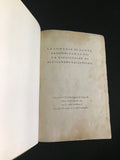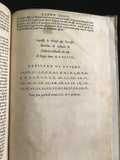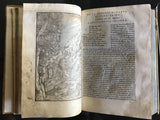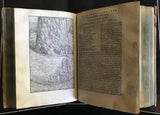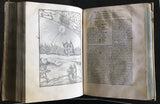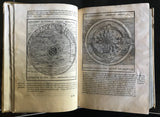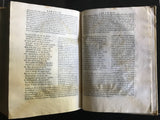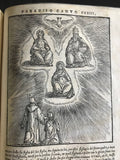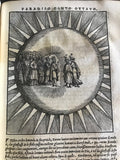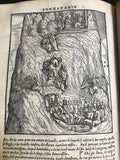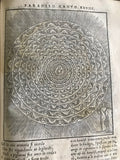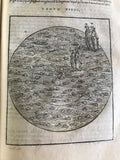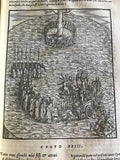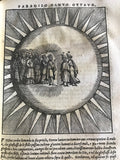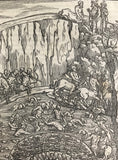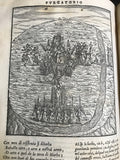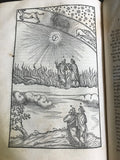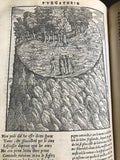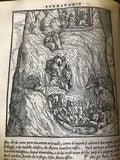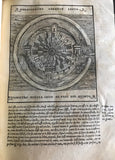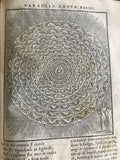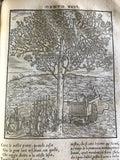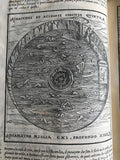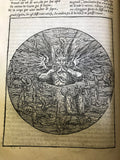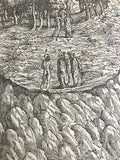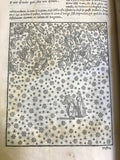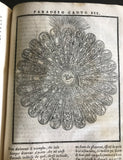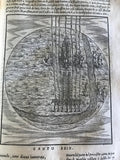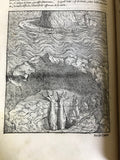FULL TITLE: LA COMEDIA DI DANTE ALIGIERI CON LA NOVA ESPOSITIONE DI ALESSANDRO VELLVTELLO: con gratia de la illustrissima signoria di vinegia, che nessuno la possa imprimere, ne impressa uendere nel termino di dieci anni, sotto le pene che in quella si contengono.
Free Worldwide Shipping
Written by Dante Alighieri (c. 1265 – 14 September 1321)
Published by [Impressa in Vinegia per Francesco Marcolini ad instantia di Alessandro Vellutello del mese di Gugno lanno MDXLIIII (1544)]
Language: Italian (Tuscan/Florentine)
DESCRIPTION:
Alighieri, Dante. La Comedia. Venice: Francesco Marcolini, (1544). First edition, In-4° (22.3 x 15 cm), 441/442 leaves, lacking last leaf blank; Collation: AA-BB8, CC10, A-Z8, AB-AZ8, BC-BI8; imprint from colophon.
First edition, 1544 printing of Dante Alighieri’s Divina Commedia (Divine Comedy) with commentary by Alessandro Vellutello, printed by Francesco Marcolini, including three full-page and 84 woodcuts, bound in full vellum of the 18th century. A few capital spaces with guide letters. The text is printed in columns, irregularly disposed, with the commentary printed in smaller type around the main text. The first 26 leaves contain a dedication to Pope Paul III, etc. There are a total of 87 woodcuts, with 2 repetitions. Three full-page woodcuts illustrate the beginning of each book (Inferno, Purgatorio, and Paradiso). Due to a print error, this edition is missing lines in Purgatorio II, 64-66 (leaf V7 recto), which have been added by hand.
The Divine Comedy (1320) is among the most influential texts of world literature, whose impact on both the European religious and literary imagination is undeniable. Linguistically, Dante's work is important as it is largely responsible for the standardization of the Tuscan/Florentine dialect as standard Italian. His use of allusion, symbolism, folklore, and history is rooted in both the classical tradition and Dante's own contemporary medieval world, resulting in a trove of medieval Italian thought and historical perspective.
Alessandro Vellutello published his influential commentary on the Divine Comedy in 1544 with Venetian printer Francesco Marcolini. The 1544 edition includes some of the "most beautiful illustrations to the poem of the Renaissance" (Lansing, 850), perhaps "executed by Giovanni Britto, who worked as an engraver for Marcolini"(Parker). In Libraria (1550), Antonfrancesco Doni notes that Velutello "strained his mind, expenses and expended considerable time" in having illustrations engraved to elucidate the text (Parker). The illustrations are considered to be "the most distinctive Renaissance renditions of the poem after Botticelli's" (Parker).
The first new commentary published in the 16th century, Vellutello's work challenged previous interpretations of the poem and is known for its "bold criticism of the previous scholarly tradition" (Alvarez). He was particularly concerned with elucidating Dante's historical and literary allusions, clarifying the material for his contemporary audience (Lansing, 850). The commentary and woodcuts, printed for the first time in the 1544 edition, were created for this printing and were later recycled throughout the 16th and 17th centuries.
CONDITION: Internally in very good condition. There are small restorations on the title page and on three other leaves with no loss of text. Some pages are browned. Some water stains found mostly on the first leaves and on the last part of "Canto of Paradise." Very light soiling of vellum, with stain mark on front cover, and vellum chipped at middle thread of front cover and small, one-inch chip of outer edge of back cover. Light wearing of vellum at corner boards. Pencil writing inside on front blank. Soiling and water stain on front page with signs of repairs. Water stain on first front pages, with age darkening and repairs. Age darkening of Prima Canta frontis engraving, and very light soiling and age darkening throughout. Yellowing of Purgatorio at the end of Canto Octavo and beginning of Canto Nono. This ends at Canto Decimo. Also occurring at several other portions, including Purgatorio in middle of Canto 30, Paradiso Canto Second and Octavo. Old repair of marginal tear on second page of Canto Nono. As well as yellowing occurring throughout Paradiso. Water stain affects the upper most portion of Paradiso. Age darkening of the last pages of the book Paradiso from Canto 32 to 33 and last page with printer's imprint, one page with minor repair. Lacking last leaf blank. The missing lines in Purgatorio II, 64-66 (leaf V7 recto) have been added by hand.
BOOK MEASUREMENTS: In-4° (22.3 x 15 cm).
TOTAL LENGTH: 441 leaves. Lacking last leaf blank; Collation: AA-BB8, CC10, A-Z8, AB-AZ8, BC-BI8; imprint from colophon.



































